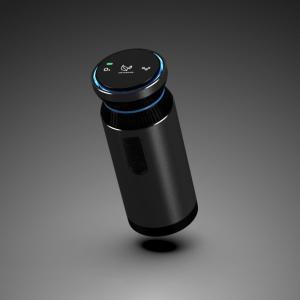
Add to Cart
USB Portable Ozone Generator Mini Car Air Purifier Anion Air Cleaner
Ozone Air Purifier Description
| Product Name | Ozone Air Purifier |
| Product Model | XT-KJ901 |
| Voltage | DC 5V |
| Power | 8W |
| Battery Capacity | 5200mAh |
| Color | Black |
| Material | high quality aluminum alloy +ABS |
| Brand | Customized |
Ozone Air Purifier Function
1.Support anion purification aromatherapy while driving
2.Support O3, ozone, formaldehyde, odor and VOC purification when parking
3.Support base of perfume: cologne
4. Support driving induction automatic start and stop technology, no manual operation, convenient and fast
5. Support 5200mAh battery capacity power supply, support Type-C 5V 2A charging
6.Support ambient breathing lamp decoration around the display screen
7. Aluminum alloy and ABS material design, high-end atmosphere innovative design
Ozone Air Purifier Parameters
1.Rated voltage: DC 5V
2.Fan: 5V DC fan with constant wind speed
3.Rated power: 8W
4.Battery capacity: 5200mAh
5.Power supply: Type-c USB 5V charging
6.Product size: φ70*178mm
7.Scope of use: car closet refrigerator drawer in addition to smell in addition to aldehyde
8.Purification principle: negative ion reactive oxygen purification
9.Main material: high quality aluminum alloy +ABS
About Ozone Air Purifier
Some devices that are advertised as air purifiers purposely emit large amounts of ozone, the main component of smog. CARB recommends that ozone generators not be used, except for approved industrial purposes where harmful exposure to ozone is prevented. Not only are ozone generators ineffective at cleaning indoor air, but inhaling ozone poses serious health risks for humans and animals. This fact sheet discusses these health risks and provides effective, alternative solutions to address indoor air quality problems.
What are ozone-generating air cleaners?
Indoor "air purifiers" or air cleaners that intentionally emit ozone are often called “ozone generators." Manufacturers sometimes inappropriately refer to ozone as “activated oxygen,” “super oxygenated” or “energized oxygen,” which implies that ozone is a healthy kind of oxygen. Because ozone reacts with some other molecules, manufacturers claim that the ozone produced by these devices can purify the air and remove airborne particles, chemicals, mold, viruses, bacteria, and odors. However, ozone is only partially effective at cleaning the air when it is used at extremely high, unsafe levels that pose a serious health risk.
Air cleaners that utilize ionizers and electrostatic precipitators are other types of devices that emit ozone, but do so as a by-product of their design and function. These devices are designed to electrically charge particles in the air and cause them to attach to surfaces in the room, such as walls or floors. Ozone is released through the charging process, although these devices typically emit much less ozone than ozone generators.
Are ozone generators effective at cleaning air?
Some devices are marketed with advertising claims that they will kill viruses, bacteria, mold and other biological contaminants, and remove chemical contaminants and odors. However, when ozone concentrations are below the health standards, it does not effectively remove biological contaminants. Ozone also does not remove particles (e.g. dust and pollen) from the air,